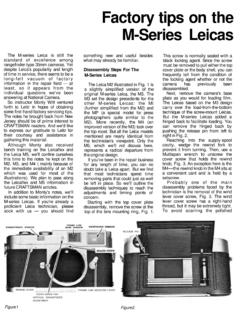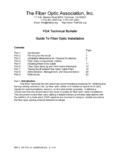Transcription of CAMERA SET, STILL PICTURE KS-15(4) - PENTAX MANUALS
1 CAMERA SET, STILL PICTURE KS-15(4). Repair Training Program **. INTRODUCTION. CHAPTER 1. GENERAL FUNCTIONING. Section I. CAMERA body Section I I . Exposure meter Section I I I . Lenses Section IV. Flash unit CHAPTER 2. TROUBLESHOOTING. Section I. CAMERA body Section II. Exposure meter Section III. Lenses Section IV. Flash unit CHAPTER 3. DISASSEMBLY. Section I. CAMERA body Section II. Exposure meter Section III. Lenses Section IV. Flash unit CHAPTER 4. REPAIR AND ALIGNING. Section I. CAMERA body Section II. Exposure meter Section III. Lenses Section IV. Flash unit CHAPTER 5. REASSEMBLY. Section I. CAMERA body Section I I . Exposure meter Section I I I . Lenses Section IV. Flash unit APPENDIX A. TOOL LIST. APPENDIX B. REFERENCES. PART 2. ILLUSTRATIONS. CAMERA SET. STILL PICTURE KS-15(4). REPAIR TRAINING PROGRAM. Government Contract F-42600-88-C-3249. INTRODUCTION. The purpose of the training program is to train experienced CAMERA repairmen in the repair adjustment and maintenance of components of the KS-15(4) CAMERA Set.
2 The course consists of 120 hours (3 weeks) and includes general functioning of the equipment and practical work. This text has been prepared especially for the course and is in two parts: Part 1. TEXT. Part 2. ILLUSTRATIONS. Course conducted at E. Leitz, Inc. 304 Hudson Street New York, I. CHAPTER I. GENERAL FUNCTIONING. Section I. CAMERA BODY. 1-1. General Description The CAMERA body, lenses and accessories supplied with the KS-15(4) CAMERA Set, together with the LE-11A photographic accessory Kit, is designed for general photographic use. It may be employed in the field, studio or laboratory. It uses 35mm perforated film (black-&-white or color) and mounts interchangeable lenses for wide-angle, normal and telephoto photography. Accessories extend the range to include close-up and photomacrography. The compensating focalplane shutter is self-capping. It is synchronized for flash bulbs at all speeds (1-second to 1/1000-second) and for electronic flash at shutter speeds up to and including 1/50-second.
3 The winding lever simultaneously tensions the shutter, advances the film and actuates the frame counter. The built-in rangefinder couples to interchangeable lenses having focal lengths from 21mm through 135mm, and may be used either as a coincident or split- image type. Bright-line frames, outlining the field, are positioned in the viewfinder when mounting the 35mm, 50mm, 90mm or 135mm lens. Parallax is automatically adjusted while focusing. A delayed action release serves as a self-timer, or for shutter release when using an unsteady support. 1-2. Shutter FIRST SHUTTER CURTAIN. SECOND SHUTTER CURTAIN. BY DIFFERENT EXPOSURE S. RELEASE MOMENT. MSEC. 1/250. 1/1000. 1/500 OPENING TIME. Figure 1 1. Shutter Functioning. The focal plane shutter employs two curtains of rubberized fabric which operate independently of each other. When the shutter is released the first curtain begins its travel across the film aperture and uncovers a portion of the film.
4 At a later interval, determined by the selected shutter speed, the second curtain is released, starts across the aperture and covers the film. The trailing edge of the first curtain. 1-1. and the leading edge of the second curtain form a slit as they traverse the film aperture. The more nar- row the slit (shorter interval before release of second curtain) the shorter the exposure; the wider the slit (longer interval between release of first and second curtain) the longer the exposure. Accurate ex- posure (slit width) is mechanically controlled by cams and levers. At the slower speeds (1-second to 1/30-second) an escapement is engaged and further delays release of the second curtain. At shutter speeds of 1/50-second and slower, the first curtain completely uncovers the film before the second curtain is released. When the shutter is wound both curtains lie approximately 7-millimeters behind the edge of the film aperture.
5 When the shutter is released the curtains travel together for approximately 4-millimeters, at which point the second curtain is arrested. The trailing edge of the first curtain enters the film aperture approximately 12-milliseconds after release of the shutter. The time required for the curtain to traverse the aperture is approximately 17-milliseconds (1/59-second). The shutter curtains, overcoming inertia during their travel, move faster as they cross the film aperture. To assure even ex- posure of the film, the slit must widen as the curtains move across the aperture. This is accomplished by the increasing diameter of shutter curtain and ribbon rollers as material is wound on them, and by different tensioning of the shutter springs. A brake mechanism applies a gradual braking action to the shutter curtains as they near the end of their run. This prevents an abrupt stop of the curtains and les- sens CAMERA vibration.
6 A. Shutter Winding (fig. 1-2, 1-3, 1-4, 1-5, 1-6). The shutter is wound and the film advanced one frame by operating the winding lever through a complete stroke. The shutter may also be wound by completing a "stroke cycle" with a series of short intermittent strokes of the winding lever. WINDING LEVER. ECCENTRIC PIN. GEAR OF DRIVE SHAFT. INTERMEDIATE GEAR A. GEAR C. GEAR D. COUPLING DISC RIBBON ROLLER SECOND CURTAIN. MAIN ROLLER RIBB0N OF SECOND CURTAIN. COMPENSATING. FRICTION SPRING ROLLER. TAKE-UP SPOOL. FILM. SPROCKET. RIBBON OF FIRST CURTAIN. WHEEL INTERMEDIATE GEAR B. GEAR Of SPROCKET GEAR OF MAW ROLLER. WHEEL SHAFT ROLLER. FIRST CURTAIN. Figure 1-2. Film Transport and Shutter, Schematic. 1-2. (1) The driveshaft gear (fig. 1-2) rotates counter-clockwise as the winding lever is moved through its operating arc. Intermediate gear "A" meshes with gear " C " of the sprocket wheel shaft.
7 (2) Two stop discs on top of gear " C " , in conjunction with two stop levers (fig. 1-3), control the stroke of the winding lever, film advance and exact shutter winding. SPEED CAM. ADJUSTING SEGMENT CHANGE-OVER DOUBLE. GUIDE LEVER GEAR CAM STOP LEVER. STOP. LEVER GEAR (DRIVE. SETTING CAM. SHAFT ASSEMBLY! SLOW SPEED. ASCAPEMENT. ANCHOR STOP DISC. STOP ARM. LOCKING LEVER. INTERMEDIATE. GEAR " A ". ADJUSTING STOP PIN DROPPING. LEVER PLATE FLANK. DISENGAGING ARRESTING GEAR OF SPROCKET. LEVER. LEVER WHEEL SHAFT. SECOND CURTAIN. ROLLER CATCH. Figure 1 3. Shutter Winding and Speed Controls. (3) The lock lever, resting on intermediate gear "A" (fig. 1-3), prevents reverse rotation of the sprocket wheel shaft if the winding operation is interrupted. (4) The lower gear (fig. 1-2) on the sprocket wheel shaft meshes with two-part intermediate gear " B " which engages a gear on the main shutter roller shaft.)
8 Operation of the winding lever rotates the main shutter roller through the gears. This simultaneously winds the second curtain on to the main roller; and by shutter curtain ribbons, pulls the first shutter curtain across the film aperture and tensions the springs of the spring rollers. Figure 1 4. Controls in 1-Second Position, Shutter Wound. 1-3. (5) When the shutter is fully wound (fig. 1-4), one of the lower ends of the spring-loaded double-stop lever engages a notch on the under-side of the drives haft gear. This prevents the winding mechanism from being overdriven. b. Shutter Speed Adjustment. Shutter speeds are selected by setting the shutter speed dial to the desired index. This adjusts the shutter control cams and levers which regulate the release of the second shutter curtain and consequent slit width. (1) Shutter speed dial set for "B". Figure 1-3 illustrates the position of shutter control cams and levers when the shutter is wound.
9 The slow-speed escapement is disengaged. The shutter slit adjusting and arresting levers are positioned to prevent release of the second shutter curtain while the shutter release is depressed. (2) Shutter set for 1 to 1/30-second (fig. 1-4). The speed cam renders the adjusting lever in- operative. The setting cam positions the adjusting guide lever and pivots the slow-speed escapement around its axis. A segment gear is actuated by a catch on the main shutter roller shaft. The slow-speed escapement controls the delay of the second curtain. The slow-speed escapement anchor is deactivated by the disengaging lever at 1/15-second and 1/30-second shutter speeds. (3) Shutter speed dial set for 1/50 to 1/1000-second. At speeds between 1/50-second (elec- tronic flash symbol) and 1/1000-second the slow-speed escapement is disengaged. The speed cam positions the adjusting lever according to the selected speed, and the highest point on the cam (fig.)
10 1-8) sets the shutter for 1/1000-second. The dropping flank, (fig.. 1-3) on the main shutter roller shaft, actuates the adjusting lever which rests against the arresting lever " B " eccentric shaft. Figure 1-8 illustrates component positions for 1/1000- second. c. Shutter Release RELEASE KNOB. ARRESTING LEVER " B ". STOP. RELEASE ROD. FLAT SPRING. ARRESTING LEVER "A". Figure 7-5. Shutter Release, Schematic. 1-4. (1) First shutter curtain (fig. 1-5). The shutter release knob, when depressed,pushes a re- lease rod against a flat spring. A projection on the flat spring rides against the beveled edge of arresting lever "A", which is spring loaded, and rotates it slightly. The arresting lever sear disengages a bar on the under side of main shutter roller assembly. The shaft of the main shutter roller assembly rotates, and the first shutter curtain runs off. Simultane- ously, the second curtain roller of the main shutter roller assembly rotates through a small arc.






